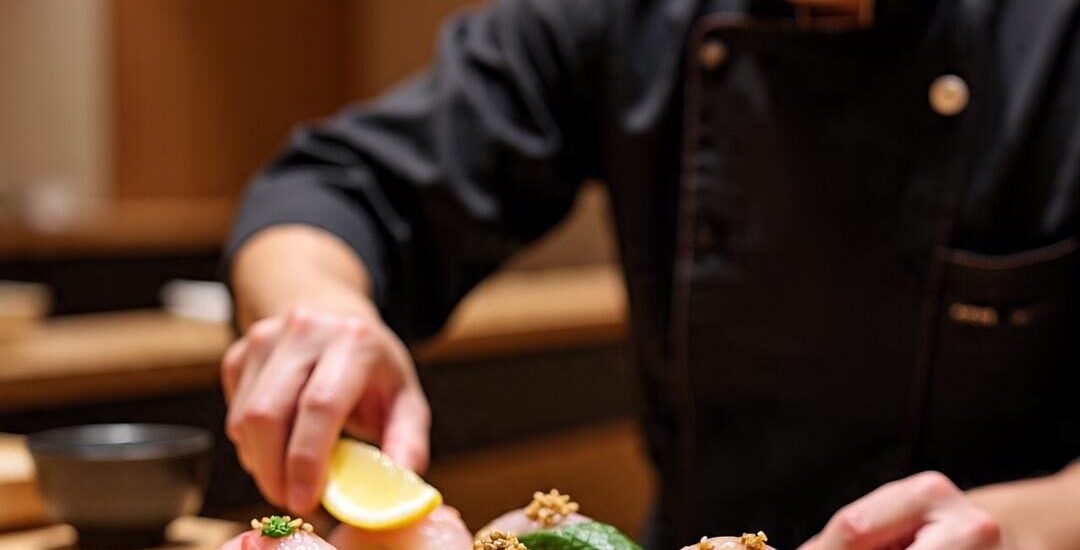*Introduction:*
Japanese cuisine is renowned for its unique flavors, ingredients, and presentation. From sushi to ramen, Japan offers a diverse and vibrant food culture that has captured the hearts of foodies worldwide. In this blog post, we’ll take a culinary journey through Japan, exploring its most popular dishes, ingredients, and dining experiences.
*Popular Japanese Dishes:*
*Sushi*: A classic Japanese dish made from vinegared rice and fresh ingredients like salmon, tuna, and avocado.
*Ramen*: A hearty noodle soup made with rich pork or chicken broth, served with vegetables and meat.
*Tempura*: Battered and fried seafood or vegetables, often served with a side of rice and dipping sauce.
*Yakitori*: Grilled chicken skewers, typically flavored with salt or teriyaki sauce.
*Unique Ingredients:*
*Miso*: A fermented soybean paste used in soups, sauces, and marinades.
*Wasabi*: A spicy condiment made from Japanese horseradish, often served with sushi.
*Matcha*: A finely ground green tea powder used in desserts, drinks, and savory dishes.
*Dining Experiences:*
*Izakayas*: Japanese gastropubs where you can enjoy small plates and drinks in a lively atmosphere.
*Sushi bars*: Traditional sushi restaurants where chefs prepare sushi in front of you.
*Street food*: Japan’s street food scene offers a variety of snacks, from yakitori to takoyaki (octopus dumplings).
*Food Culture:*
*Seasonality*: Japanese cuisine emphasizes using seasonal ingredients to ensure freshness and flavor.
*Presentation*: Japanese dishes are often presented with attention to detail, emphasizing aesthetics and visual appeal.
*Community*: Mealtimes in Japan are often seen as opportunities to bond with family and friends.
*Conclusion:*
Japan’s food culture is a reflection of its rich history, traditions, and values. From traditional dishes to modern twists, Japan offers a culinary experience like no other. Whether you’re a food enthusiast or just curious about different cultures, Japan’s cuisine is sure to delight your senses.*Introduction:*
Japanese cuisine is renowned for its unique flavors, ingredients, and presentation. From sushi to ramen, Japan offers a diverse and vibrant food culture that has captured the hearts of foodies worldwide. In this blog post, we’ll take a culinary journey through Japan, exploring its most popular dishes, ingredients, and dining experiences.
*Popular Japanese Dishes:*
*Sushi*: A classic Japanese dish made from vinegared rice and fresh ingredients like salmon, tuna, and avocado.
*Ramen*: A hearty noodle soup made with rich pork or chicken broth, served with vegetables and meat.
*Tempura*: Battered and fried seafood or vegetables, often served with a side of rice and dipping sauce.
*Yakitori*: Grilled chicken skewers, typically flavored with salt or teriyaki sauce.
*Unique Ingredients:*
*Miso*: A fermented soybean paste used in soups, sauces, and marinades.
*Wasabi*: A spicy condiment made from Japanese horseradish, often served with sushi.
*Matcha*: A finely ground green tea powder used in desserts, drinks, and savory dishes.
*Dining Experiences:*
*Izakayas*: Japanese gastropubs where you can enjoy small plates and drinks in a lively atmosphere.
*Sushi bars*: Traditional sushi restaurants where chefs prepare sushi in front of you.
*Street food*: Japan’s street food scene offers a variety of snacks, from yakitori to takoyaki (octopus dumplings).
*Food Culture:*
*Seasonality*: Japanese cuisine emphasizes using seasonal ingredients to ensure freshness and flavor.
*Presentation*: Japanese dishes are often presented with attention to detail, emphasizing aesthetics and visual appeal.
*Community*: Mealtimes in Japan are often seen as opportunities to bond with family and friends.
*Conclusion:*
Japan’s food culture is a reflection of its rich history, traditions, and values. From traditional dishes to modern twists, Japan offers a culinary experience like no other. Whether you’re a food enthusiast or just curious about different cultures, Japan’s cuisine is sure to delight your senses.*Introduction:*
Japanese cuisine is renowned for its unique flavors, ingredients, and presentation. From sushi to ramen, Japan offers a diverse and vibrant food culture that has captured the hearts of foodies worldwide. In this blog post, we’ll take a culinary journey through Japan, exploring its most popular dishes, ingredients, and dining experiences.
*Popular Japanese Dishes:*
*Sushi*: A classic Japanese dish made from vinegared rice and fresh ingredients like salmon, tuna, and avocado.
*Ramen*: A hearty noodle soup made with rich pork or chicken broth, served with vegetables and meat.
*Tempura*: Battered and fried seafood or vegetables, often served with a side of rice and dipping sauce.
*Yakitori*: Grilled chicken skewers, typically flavored with salt or teriyaki sauce.
*Unique Ingredients:*
*Miso*: A fermented soybean paste used in soups, sauces, and marinades.
*Wasabi*: A spicy condiment made from Japanese horseradish, often served with sushi.
*Matcha*: A finely ground green tea powder used in desserts, drinks, and savory dishes.
*Dining Experiences:*
*Izakayas*: Japanese gastropubs where you can enjoy small plates and drinks in a lively atmosphere.
*Sushi bars*: Traditional sushi restaurants where chefs prepare sushi in front of you.
*Street food*: Japan’s street food scene offers a variety of snacks, from yakitori to takoyaki (octopus dumplings).
*Food Culture:*
*Seasonality*: Japanese cuisine emphasizes using seasonal ingredients to ensure freshness and flavor.
*Presentation*: Japanese dishes are often presented with attention to detail, emphasizing aesthetics and visual appeal.
*Community*: Mealtimes in Japan are often seen as opportunities to bond with family and friends.
*Conclusion:*
Japan’s food culture is a reflection of its rich history, traditions, and values. From traditional dishes to modern twists, Japan offers a culinary experience like no other. Whether you’re a food enthusiast or just curious about different cultures, Japan’s cuisine is sure to delight your senses.*Introduction:*
Japanese cuisine is renowned for its unique flavors, ingredients, and presentation. From sushi to ramen, Japan offers a diverse and vibrant food culture that has captured the hearts of foodies worldwide. In this blog post, we’ll take a culinary journey through Japan, exploring its most popular dishes, ingredients, and dining experiences.
*Popular Japanese Dishes:*
*Sushi*: A classic Japanese dish made from vinegared rice and fresh ingredients like salmon, tuna, and avocado.
*Ramen*: A hearty noodle soup made with rich pork or chicken broth, served with vegetables and meat.
*Tempura*: Battered and fried seafood or vegetables, often served with a side of rice and dipping sauce.
*Yakitori*: Grilled chicken skewers, typically flavored with salt or teriyaki sauce.
*Unique Ingredients:*
*Miso*: A fermented soybean paste used in soups, sauces, and marinades.
*Wasabi*: A spicy condiment made from Japanese horseradish, often served with sushi.
*Matcha*: A finely ground green tea powder used in desserts, drinks, and savory dishes.
*Dining Experiences:*
*Izakayas*: Japanese gastropubs where you can enjoy small plates and drinks in a lively atmosphere.
*Sushi bars*: Traditional sushi restaurants where chefs prepare sushi in front of you.
*Street food*: Japan’s street food scene offers a variety of snacks, from yakitori to takoyaki (octopus dumplings).
*Food Culture:*
*Seasonality*: Japanese cuisine emphasizes using seasonal ingredients to ensure freshness and flavor.
*Presentation*: Japanese dishes are often presented with attention to detail, emphasizing aesthetics and visual appeal.
*Community*: Mealtimes in Japan are often seen as opportunities to bond with family and friends.
*Conclusion:*
Japan’s food culture is a reflection of its rich history, traditions, and values. From traditional dishes to modern twists, Japan offers a culinary experience like no other. Whether you’re a food enthusiast or just curious about different cultures, Japan’s cuisine is sure to delight your senses.





